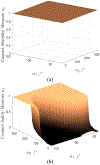Analysis of Contact Stability and Contact Safety of a Robotic Intravascular Cardiac Catheter under Blood Flow Disturbances
- PMID: 34079624
- PMCID: PMC8165756
- DOI: 10.1109/iros45743.2020.9341527
Analysis of Contact Stability and Contact Safety of a Robotic Intravascular Cardiac Catheter under Blood Flow Disturbances
Abstract
This paper studies the contact stability and contact safety of a robotic intravascular cardiac catheter under blood flow disturbances while in contact with tissue surface. A probabilistic blood flow disturbance model, where the blood flow drag forces on the catheter body are approximated using a quasi-static model, is introduced. Using this blood flow disturbance model, probabilistic contact stability and contact safety metrics, employing a sample based representation of the blood flow velocity distribution, are proposed. Finally, the contact stability and contact safety of a MRI-actuated robotic catheter are analyzed using these models in a specific example scenario under left pulmonary inferior vein (LIV) blood flow disturbances.
Figures









References
-
- Chowdhury P, Lewis WR, Schweikert RA, and Cummings JE, “Ablation of atrial fibrillation: What can we tell our patients?” Cleveland Clinic Journal of Medicine, vol. 76, no. 9, pp. 543–550, 2009. - PubMed
-
- Yip MC, Sganga JA, and Camarillo DB, “Autonomous control of continuum robot manipulators for complex cardiac ablation tasks,” Journal of Medical Robotics Research, vol. 2, no. 01, p. 1750002, 2017.
-
- Kesner SB and Howe RD, “Robotic catheter cardiac ablation combining ultrasound guidance and force control,” The International Journal of Robotics Research, vol. 33, no. 4, pp. 631–644, 2014.
-
- Bebek O and Cavusoglu MC, “Intelligent control algorithms for robotic-assisted beating heart surgery,” IEEE Transactions on Robotics, vol. 23, no. 3, pp. 468–480, 2007.
Grants and funding
LinkOut - more resources
Full Text Sources
